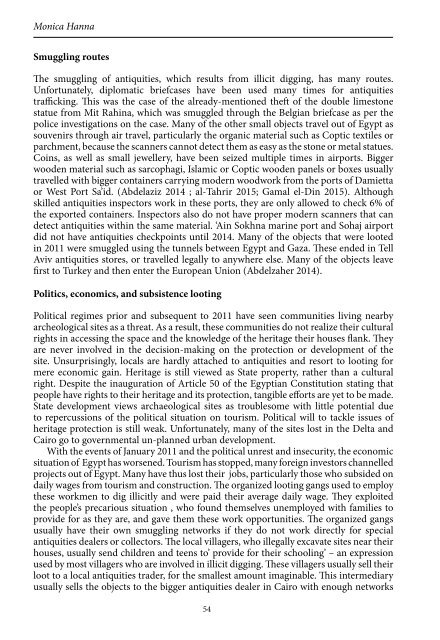Countering
Book_observatory_illicit_traffic_version%20issuu
Book_observatory_illicit_traffic_version%20issuu
You also want an ePaper? Increase the reach of your titles
YUMPU automatically turns print PDFs into web optimized ePapers that Google loves.
Looting Activities in Post-2011 Egypt<br />
to smuggle the object outside of the country. Many of the people involved in looting are<br />
not doing it to provide food for the table or to continue schooling: unfortunately, the<br />
larger percentage keeps digging out of greed. There is a strong market for these objects,<br />
and wealth is easily acquired.<br />
Religion and superstition<br />
Religion plays an important role in Egyptian society. Most belonging to both the Muslim<br />
majority and the Christian minority are deeply religious. Unfortunately, with the Wahhabi<br />
influence on Egyptian Islam, many fatwas were issued against Ancient Egypt, and stated<br />
that trade in antiquities is not a religious fault as long as you do not sell statues insofar<br />
as they are probable idols. A famous cleric, Shaykh Muhammad Hassan has issued the<br />
fatwa in 2010 and many have taken it seriously. Due to media pressure, Hassan has<br />
withdrawn his fatwa (Abdelsalam 2010). In 2011, another Shaykh called Muhammad<br />
Shahhat of the Salafi Da’wa in Alexandria declared that the Ancient Egyptian culture is<br />
rotten and statues should be covered in wax (Sabri 2015).<br />
Although the Coptic minority usually takes pride in its heritage and intimate bond<br />
with Ancient Egypt, many of conservative priests affirm that the Ancient Egyptian<br />
civilization was evil – the persecutors of Moses. This creates aversion and distrust in this<br />
heritage. As a consequence, many in the Coptic community are also involved in dealing<br />
in Coptic antiquities.<br />
Most looters bring shaykhs famed for their magical powers to tell them where to dig<br />
for antiquities. Regular villagers who cannot afford a geo-sonar will beseech a shaykh<br />
to use his powers to locate the ‘treasure’. In Dayr Abu Hennes, Mallawi in Minya, near<br />
the rock-cut Coptic remains of Ansina, Coptic looters asked a Muslim shaykh from the<br />
nearby village to guide them in their excavations. (al-Bagoushi 2013).<br />
Antiquities, market and laundering<br />
The market in Egyptian antiquities has flourished since 2011. Many Ancient Egyptian<br />
objects reached auctions and collectors in Europe and the United states, while many of<br />
the Islamic ones went to the Gulf Area 3 . Several Biblical scholarly institutions, particularly<br />
in the United States, have bought Coptic manuscripts and objects of a lower value have<br />
been sold on e-commerce website ebay as well as other websites in plentiful quantities<br />
(Fig. 7). This has given antiquities traders a huge advantage, inasmuch as the tracking of<br />
their channels has become very difficult.<br />
In addition, numerous auctions selling antiquities have laundered their certificates of<br />
origin. The best example is the double limestone statue sold in Belgium. This statue was<br />
illegally sold along with another serpentine statue: the sale took place in an auction with<br />
papers that attested it came from another old collection (Abdelzaher 2014; Billen 2014:<br />
20-21). Most Egyptian objects on the antiquities market and sold as ‘old collections’<br />
come from illicit excavations with false documents.<br />
55


